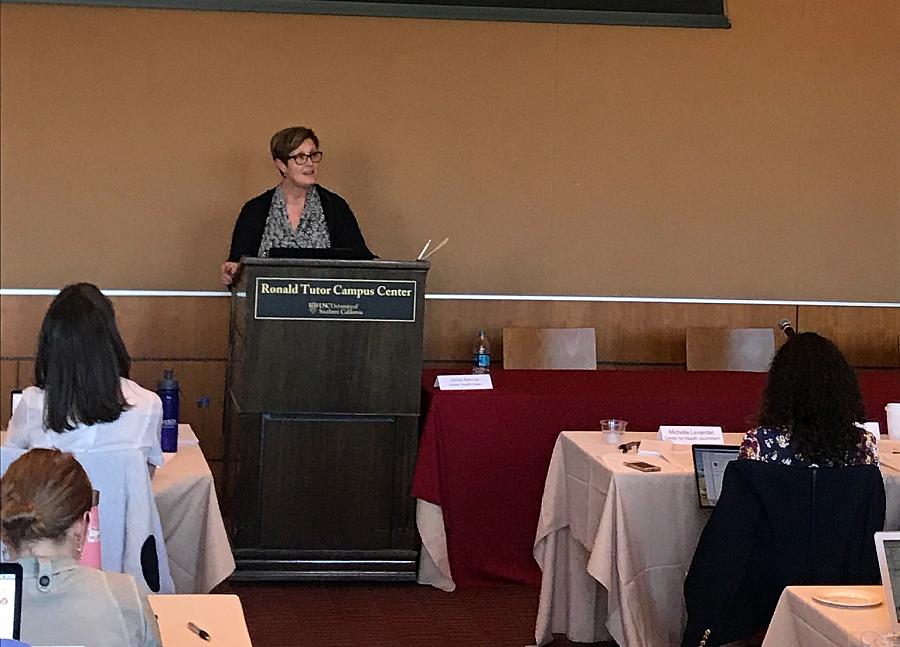KHN's JoNel Aleccia talks about how to give your reporting more impact

JoNel Aleccia talks to fellow reporters at the 2019 California Fellowship.
(Photo by Chinyere Amobi/CHJ)
Find the people who can tell the story. Scrutinize death records. Isolate the levers that can create change.
Those are a few of the tips veteran reporter JoNel Aleccia shared with fellows at the 2019 California Fellowship this week while discussing how to give health stories impact. Aleccia, a senior correspondent with Kaiser Health News, told reporters that her deep engagement with the community she was covering was crucial to her investigation for The Seattle Times into why dozens of infants were born with a rare and fatal birth defect in Washington state.
After combing through federal health reports and seeing social media posts about anencephaly, a condition in which a major portion of the brain, skull, and scalp are missing, Aleccia discovered the disorder was increasing in three rural counties in Washington.
There were a total of 42 cases of anencephaly from 2010 to 2015, according to the Centers for Disease Control and Prevention. That meant that the rate in Washington state was about 9.5 per 10,000 babies. The national average at the time was two cases per 10,000 babies.
What was driving the spike in cases? Aleccia wondered. And what were Washington state health officials doing about it?
The state wasn’t doing much, Aleccia learned, and that too became a key part of the story. The state's inaction was a critical oversight, and an area where Aleccia could use her reporting to bring about change, as she would find.
But before that could happen, Aleccia dug far and deep. She examined death records, openly available in Washington state, for names and addresses of parents who had lost children to anencephaly. She asked the Catholic diocese in Yakima to distribute more than 15,000 postcards to families at Christmas time that included information about anencephaly in a bid to both educate and find where birth defects had occurred. She even visited funeral homes to look for the names of mothers and fathers who had lost their infants to anencephaly.
"The first thing about impact is finding the people who can tell you these stories," Aleccia said.
Her search yielded several interviews with parents such as Sally Garcia, who talked about a mysterious condition that caused her baby daughter to die only 55 minutes after birth. After she found the parents, doctors were more willing to step out from under the banner of federal health privacy laws and talk too, Aleccia said.
"Nobody knew why (anencephaly was increasing) and nobody was looking particularly hard," Aleccia said, referring to the state's lack of action. Could anencephaly be genetic or environmental? Was it caused by a lack of a key nutrient?
Since state officials had done little to find the cause, Aleccia turned to outside experts far and wide with expertise in anencephaly and birth defects.
"What I did and what I would recommend: First of all you have to become an expert in what it is you're looking at it," Aleccia said. "I had to become an expert in anencephaly. Find the expert not just in your county and in your state, but in the world."
A retired CDC expert told her anencephaly was caused by a lack of folic acid.
Many grain-based foods are already fortified with folic acid, but not corn masa, a staple used to make food such as tortillas and tortilla chips.
With those expert interviews, emotional testimonies from parents, and data, headlines began to roll out in The Seattle Times, where Aleccia was a reporter at the time.
As a result of her stories, state health officials soon agreed to be more transparent with parents about the condition and changed a state Medicaid rule to give more women access to vitamins that can help prevent the deadly disorder. The U.S. Food and Drug Administration also encouraged manufacturers to add folic acid to corn masa as a result of the stories. But manufacturers weren’t required to do so, and to date many have not fortified their corn masa with folic acid.
Alecia said her reporting impact was made through several methods that she continues to use for other stories:
- Have a specific plan: What kind of impact are you seeking to make?
- Focus your efforts: What levers can you push for change.
- Be creative: Postcards? Podcasts? How will you reach your intended audience?
- Document reactions: Keep track of the public conversations about your work, not just specific results.
Not all stories will make an impact, Aleccia said, but deeply reported stories will educate people and be remembered. That too is a form of impact, she added.
"If I could, I would encourage you to be as creative as possible," Aleccia said. "Look and see who has to track whatever it is your following, and do a records request. Go find the actual humans. Cold call them. Surprisingly, people wanted to talk when I went into the funeral home in the area."
